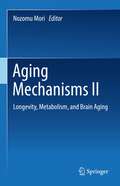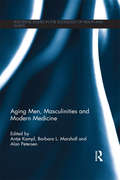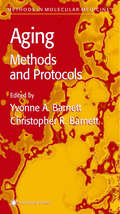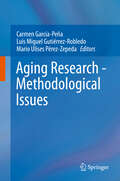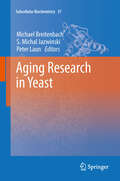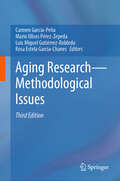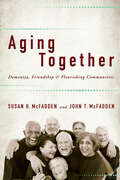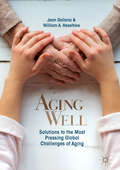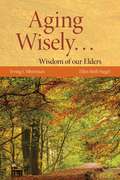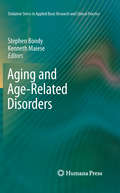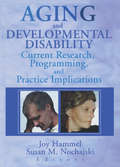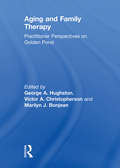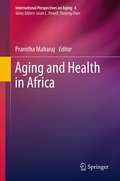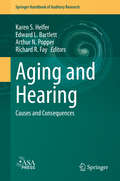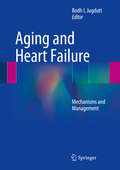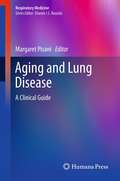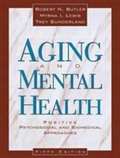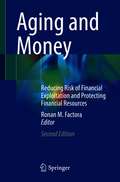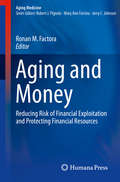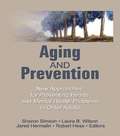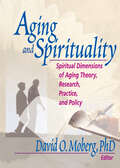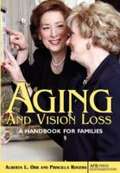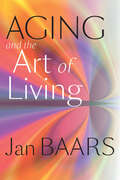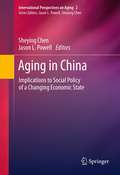- Table View
- List View
Aging Mechanisms II: Longevity, Metabolism, and Brain Aging
by Nozomu MoriThis book describes the recent advancement of basic research on the biology of aging and longevity studies in various organisms, as well as the neurobiology of aging and neurodegeneration mechanisms. Chapters present new findings and conceptual developments concerning the basic mechanisms of aging and longevity determination. As a follow-up volume to the previous book Aging Mechanisms (2015), it overviews the rapid progress of aging research introducing new topics from leading laboratories in Japan. Chapter contributors are selected based on recent scientific achievements on the mechanisms of aging in various model organisms, including yeast, worm (C. elegans), fly (Drosophila), mice, and rats. Chapters are ordered from the discussion on molecular and cellular levels to physiological and systemic levels. The book also provides an overview of aging science in the region and helps readers quickly grasp who is doing what in this research area. As the aging of population becomes an ever more pressing issue in Asia, advancing the understanding of basic mechanisms of organism aging and longevity determination will be crucial to developing more effective therapies and protective strategies. Researchers and graduate students in biomedical aging research will find this as a rich source of information and a stimulus to novel research directions.
Aging Men, Masculinities and Modern Medicine
by Alan Petersen Antje Kampf Barbara L. MarshallAging Men, Masculinities and Modern Medicine explores the multiple socio-historical contexts surrounding men’s aging bodies in modern medicine from a global perspective. The first of its kind, it investigates the interrelated aspects of aging, masculinities and biomedicine, allowing for a timely reconsideration of the conceptualisation of aging men within the recent explosion of social science studies on men’s health and biotechnologies including anti-aging perspectives. This book discusses both healthy and diseased states of aging men in medical practices, bringing together theoretical and empirical conceptualisations. Divided into four parts it covers: Historical epistemology of aging, bodies and masculinity and the way in which the social sciences have theorised the aging body and gender. Material practices and processes by which biotechnology, medical assemblages and men’s aging bodies relate to concepts of health and illness. Aging experience and its impact upon male sexuality and identity. The importance of men’s roles and identities in care-giving situations and medical practices. Highlighting how aging men’s bodies serve as trajectories for understanding wider issues of masculinity, and the way in which men’s social status and men’s roles are made in medical cultures, this innovative volume offers a multidisciplinary dialogue between sociology of health and illness, anthropology of the body and gender studies.
Aging Methods and Protocols (Methods in Molecular Medicine #38)
by Yvonne A. Barnett Christopher R. BarnettYvonne and Christopher Barnett and a team of recognized international experts detail key biochemical, analytical, and molecular techniques for the investigation of aging at the cellular, tissue, organ, and whole system levels. These cutting-edge methods address a wide range of research needs, from uncovering the factors associated with cell senescence and death, to exploring alterations in the body's ability both to metabolize xenobiotics and to defend itself against biomolecular damage. State-of-the-art protocols also measure the morphological, functional, and molecular changes that accumulate within mitochrondria over time, and permit the genetic and functional characteristics of the immune system to be determined. Wide ranging and highly practical, Aging Methods and Protocols provides today's molecular gerontologists, pharmacologists, and clinical investigators with a gold-standard collection of readily reproducible techniques for identifying those key cellular and molecular processes that might one day make it possible to regulate the aging process.
Aging Research - Methodological Issues
by Carmen García-Peña, Luis Miguel Gutiérrez-Robledo and Mario Ulises Pérez-ZepedaThis book reviews classical epidemiological and clinical research studies, with a focus on aging. Chapters cover methodological topics like the scientific method, ethics, and the consequences of certain exclusion criteria and the work includes a look at clinical concepts like multi morbidity, frailty and functionality. The authors reveal the issues and challenges for researchers of age and aging, and also consider the translation of scientific knowledge, from basic to clinical and from clinical to public policies of social and health care.The focus on aging is what gives this book its valuable perspective on research methodology. All authors have considerable experience in aging, geriatrics or gerontology and each chapter includes both a theoretical framework and practical examples of studies in aging. Readers will discover study designs that are reviewed for basic structure, main flaws and advantages and are analyzed for specific conditions and variables regarding aging.This text is suited to both health care professionals caring for older adults and researchers who are new to research in aging. It is relevant across the disciplines, including medicine, psychology, social sciences and dentistry and it supports learning with graphs and figures.
Aging Research in Yeast (Subcellular Biochemistry #57)
by Michael Breitenbach Peter Laun S. Michal JazwinskiThis volume includes contributions by the leading experts in the field of yeast aging. Budding yeast (Saccharomyces cerevisiae) and other fungal organisms provide models for aging research that are relevant to organismic aging and to the aging processes occurring in the human body. Replicative aging, in which only the mother cell ages while the daughter cell resets the clock to zero is a model for the aging of stem cell populations in humans, while chronological aging (measured by survival in stationary phase) is a model for the aging processes in postmitotic cells (for instance, neurons of the brain). Most mechanisms of aging are studied in yeast. Among them, this book discusses: mitochondrial theories of aging, emphasizing oxidative stress and retrograde responses; the role of autophagy and mitophagy; the relationship of apoptosis to aging processes; the role of asymmetric segregation of damage in replicative aging; the role of replication stress; and the role of the cytoskeleton in aging. Modern methods of yeast genetics and genomics are described that can be used to search for aging-specific functions in a genome-wide unbiased fashion. The similarities in the pathology of senescence (studied in yeast) and of cancer cells, including genome instability, are examined.
Aging Research—Methodological Issues
by Carmen García-Peña Luis Miguel Gutiérrez-Robledo Mario Ulises Pérez-Zepeda Rosa Estela García-ChanesThe aim of our book is to describe the latest developments on aging research methodology , building upon previous editions, and updating the contents. Current topics are to be approached from the research perspective and the underpinnings of those studies aimed at unveiling the fine pathway of aging. The chapters reflect the state-of-the-art methods and their different variations that will clarify problematic issues faced when investigating the impact of time on the biology of live beings (mainly humans). In addition, this work aims to stimulate new questions and innovative approaches from the readers. Finally, content will interest professionals from different disciplines and different levels of expertise.
Aging Together: Dementia, Friendship, and Flourishing Communities
by Susan H. McFadden John T. McFaddenNever in human history have there been so many people entering old age—roughly one-third of whom will experience some form of neurodegeneration as they age. This seismic demographic shift will force us all to rethink how we live and deal with our aging population.Susan H. McFadden and John T. McFadden propose a radical reconstruction of our societal understanding of old age. Rather than categorizing elders based on their cognitive consciousness, the McFaddens contend that the only humanistic, supportive, and realistic approach is to find new ways to honor and recognize the dignity, worth, and personhood of those journeying into dementia. Doing so, they argue, counters the common view of dementia as a personal tragedy shared only by close family members and replaces it with the understanding that we are all living with dementia as the baby boomers age, particularly as early screening becomes more common and as a cure remains elusive. The McFaddens' inclusive vision calls for social institutions, especially faith communities, to build supportive, ongoing friendships that offer hospitality to all persons, regardless of cognitive status. Drawing on medicine, social science, philosophy, and religion to provide a broad perspective on aging, Aging Together offers a vision of relationships filled with love, joy, and hope in the face of a condition that all too often elicits anxiety, hopelessness, and despair.
Aging Well: Solutions to the Most Pressing Global Challenges of Aging
by William A. Haseltine Jean GalianaThis open access book outlines the challenges of supporting the health and wellbeing of older adults around the world and offers examples of solutions designed by stakeholders, healthcare providers, and public, private and nonprofit organizations in the United States. The solutions presented address challenges including: providing person-centered long-term care, making palliative care accessible in all healthcare settings and the home, enabling aging-in-place, financing long-term care, improving care coordination and access to care, delivering hospital-level and emergency care in the home and retirement community settings, merging health and social care, supporting people living with dementia and their caregivers, creating communities and employment opportunities that are accessible and welcoming to those of all ages and abilities, and combating the stigma of aging. The innovative programs of support and care in Aging Well serve as models of excellence that, when put into action, move health spending toward a sustainable path and greatly contribute to the well-being of older adults.
Aging Wisely... Wisdom of Our Elders
by Ellen Beth Siegel Irving SilvermanAging Wisely… Wisdom of our Elders is a unique resource that reflects the ideas, opinions and experiences of a diverse group of senior citizens. Each story provides a unique perspective on the physical, emotional, and social aspects of growing old from those who have made the journey.
Aging and Age-Related Disorders (Oxidative Stress in Applied Basic Research and Clinical Practice)
by Stephen Bondy Kenneth MaieseFeatures that characterize the aging process include the gradual accumulation of cell damage after prolonged exposure to oxidative and inflammatory events over a lifetime. In addition to the accretion of lesions, the intrinsic levels of pro-oxidant and aberrant immune responses are elevated with age. These adverse events are often further enhanced by the chronic and slow progressing diseases that characterize the senescent brain and cardiovascular system. The incidence of some disorders such as Alzheimer's disease and vascular diseases are sufficiently prevalent in the extreme elderly that these disorders can arguably be considered "normal". Aging and Aging-Related Disorders examines the interface between normal and pathological aging, and illustrates how this border can sometimes be diffuse. It explores and illustrates the processes underlying the means by which aging becomes increasingly associated with inappropriate levels of free radical activity and how this can serve as a platform for the progression of age-related diseases. The book provides chapters that examine the interactive relationship between systems in the body that can enhance or sometimes even limit cellular longevity. In addition, specific redox mechanisms in cells are discussed. Another important aspect for aging discussed here is the close relationship between the systems of the body and exposure to environmental influences of oxidative stress that can affect both cellular senescence and a cell's nuclear DNA. What may be even more interesting to note is that these external stressors are not simply confined to illnesses usually associated with aging, but can be evident in maturing and young individuals. A broad range of internationally recognized experts have contributed to this book. Their aim is to successfully highlight emerging knowledge and therapy for the understanding of the basis and development of aging-related disorders.
Aging and Developmental Disability: Current Research, Programming, and Practice Implications
by Joy Hammel Susan NochajskiAging and Developmental Disability: Current Research, Programming, and Practice Implications explores research findings and their implications for practice in relation to normative and disability-related aging experiences and issues. This valuable book discusses the effectiveness of specific interventions targeted toward aging adults with developmental disabilities such as Down's Syndrome, cerebral palsy, autism, and epilepsy, and offers suggestions for practice and future research in this area.
Aging and Family Therapy: Practitioner Perspectives on Golden Pond
by George Hughston Victor Christopherson Marilyn BojeanEnhance the intervention strategies you use in therapy with older adults and their families. This significant new book provides practitioners with information, insight, reference sources, and other valuable tools that will contribute to more effective intervention with the elderly and their families. Outstanding scholars have contributed original material that addresses the major issues in treating the elderly from the practitioner’s point of view; the biological, psychological, social, and spiritual concerns of the aged are examined in order to formulate a systemic and comprehensive treatment plan. Destined to become a classic in a challenging new area of psychotherapy, the unique Aging and Family Therapy promises to guide and inform practitioners who will be called upon to provide assistance to the increasing number of older adults who will be in need of mental health services.
Aging and Health in Africa (International Perspectives on Aging #4)
by Pranitha MaharajPopulation aging is a matter of global concern. It often occurs in tandem with changes in the health profile of the population. In Africa, many countries are already facing a high burden of communicable diseases. However, as more and more children survive childhood and move on to adult years and old age they are also more likely to experience health problems associated with the aging process. Population aging in Africa is occurring in the context of high levels of poverty, changing family structures, an immense disease burden, fragile health systems and weak or poorly managed government institutions. This book shows that aging is likely to lead to increased social and economic demands for the continent. However, most national governments in Africa have not begun to address the issue of how to respond effectively to the needs of the older population. This will require a better understanding of the socio-economic and demographic situation of the older population in Africa. This book fills the gaps that exist by exploring the social realities of population aging in Africa. It also focuses on the policy and programmatic responses, gaps and future challenges related to aging across the continent.
Aging and Hearing: Causes and Consequences (Springer Handbook of Auditory Research #72)
by Arthur N. Popper Richard R. Fay Karen S. Helfer Edward L. BartlettSince the first edition of the Aging Auditory System volume (in 2009), there has been a tremendous amount of research in basic, translational, and clinical sciences related to age-related changes in auditory system structure and function. The new research has been driven by technical and conceptual advances in auditory neuroscience at multiple levels ranging from cells to cognition. The chapters in Aging and Hearing: Causes and Consequences span a broad range of topics and appeal to a relatively wide audience. Our goal in this volume is to put together state-of-the-art discussions about new developments in aging research that will appeal to a broad audience, serving as an important update on the current state of research on the aging auditory system. This update includes not only the recent research, but also consideration of how human and animal studies or translational and basic research are working in tandem to advance the field. This new edition is a natural complement to the previous SHAR volume on the aging auditory system edited by Gordon-Salant, Frisina, Popper, and Fay.The target audience for this volume will be graduate students, researchers, and academic faculty from a range of disciplines (psychology, hearing science/audiology, physiology, neuroscience, engineering). It also will appeal to clinical audiologists as well as to researchers working in the hearing device industry. Individuals who attend conferences sponsored by the Association for Research in Otolaryngology, Acoustical Society of America, Auditory Cognitive Neuroscience Society, American Auditory Society, Society for Neuroscience, American Speech, Language and Hearing Association, and the American Academy of Audiology (among others) are likely to find value in the volume.
Aging and Heart Failure: Mechanisms and Management
by Bodh I. JugduttThis book synthesizes the major research advances in molecular, biochemical and translational aspects of aging and heart failure over the last four decades and addresses future directions in management and drug discovery. It presents clinical issues and molecular mechanisms related to heart failure, including the changing demographics in the aging population with heart failure; hypertension and prevention of diastolic heart failure in the aging population; polypharmacy and adverse drug reactions in the aging population with heart failure; changes in the heart that accompany advancing age from humans to molecules; aging-associated alterations in myocardial inflammation and fibrosis and aging-related changes in mitochondrial function and implications for heart failure therapy. The book succinctly summarizes the large volume of data on these key topics and highlights novel pathways that need to be explored. Featuring contributions from leading clinician-scientists, Aging and Heart Failure: Mechanisms and Management is an authoritative resource on the major clinical issues in heart failure therapy in the elderly for cardiologists, gerontologists and internists.
Aging and Lung Disease: A Clinical Guide (Respiratory Medicine)
by Margaret PisaniPeople age 65 and older are the fastest growing segment of the U.S. population. In the 2010 census 16% of the population, 50 million people, were age 65 and older. That number is projected to increase to 66 million by the year 2050. Life expectancy has also increased, with recent CDC reports indicating life expectancy at 77.9 years. Age-adjusted death rates have decreased significantly with the largest changes occurring in older patients. Despite these trends, the 10 leading causes of death include several pulmonary etiologies including lung cancer, chronic respiratory diseases, influenza and pneumonia. Aging and Lung Disease: A Clinical Guide is devoted to understanding the impact of respiratory diseases in older patients. It includes reviews of physiology of the aging lung, allergy and immunology of the aging, as well as sleep changes over the life cycle. There are also comprehensive reviews on specific disease topics including chronic obstructive lung disease, lung cancer, atypical mycobacteria, interstitial lung disease, pulmonary hypertension, pulmonary embolism, obstructive sleep apnea, sleep disorders in older patients. Two chapters focus on unique issues in older patients; HIV and lung transplant. Included also are important chapters on assessing functional and cognitive status and end-of-life issues in older patients with lung disease. In addition to outlining the current state of knowledge, each chapter focuses on special considerations when caring for older patients. Of particular interest to pulmonologists, internists, and gerontologists, other readers, such as pulmonary and geriatric nurse practitioners, as well as clinical researchers interested in both pulmonary and aging issues, will find Aging and Lung Disease: A Clinical Guide to be a vital resource for improving their care of older patients with lung disorders.
Aging and Mental Health: Positive Psychosocial and Biomedical Approaches
by Robert N. Butler Myrna I. Lewis Trey SunderlandDesigned for professionals working with the elderly, this text provides comprehensive coverage of the ageing process and its effects on mental health. It sets out the nature and problems of old age, including the problems of older people in their families, and explores some of the common emotional problems and psychiatric disorders which can affect the elderly. It also outlines the evaluation, treatment and prevention of some common effects of ageing. There is specific coverage of race, ethnicity, gender, crime, alcoholism and physical disabilities, including deafness and blindness.
Aging and Money: Reducing Risk of Financial Exploitation and Protecting Financial Resources (Aging Medicine Ser.)
by Ronan M. FactoraThis book aims to disseminate and share knowledge about financial exploitation of elders with the purpose of protecting those individuals in our society who are most vulnerable to financial abuse and mistreatment. It instructs practicing clinicians in identification of risk factors, recognition of signs, and implementation of screening methods to protect their patients. This updated edition expands upon and advances the earlier text by including the most recent research and methods used to assess risk of financial exploitation, as well as updates in how the law approaches such cases. It also highlights ways in which community awareness can aid in identifying those most at risk, effectively protecting the elderly community, advocating for those victimized, and pursuing perpetrators to the fullest extent of the law. Professionals from law enforcement, medical clinics, financial institutions, and the legal field are now tasked with acting on suspected situations thanks to increasing recognition of financial abuse and mistreatment of an aging population. This book also guides professionals on how to discuss this information with potential victims. This second edition of Aging and Money expands the knowledge base to highlight the perspectives of different disciplines including professionals in medicine, law, the financial industry, and social services who play an important role in investigating and preventing financial abuse of the elderly.
Aging and Money: Reducing Risk of Financial Exploitation and Protecting Financial Resources (Aging Medicine)
by Ronan M. FactoraIncreasingly, we hear of more and more elders falling victim to financial exploitation. Although this form of elder abuse has been recognized for years, its incidence, prevalence, and impact on the common individual has been only more recently brought to the spotlight. Despite these circumstances, recognition of risk factors and indicators of financial exploitation are not widely disseminated. Additionally, once situations are identified and confronted, the knowledge of what to do next is lacking. These gaps are present within the medical community, law-enforcement, and the finance community - areas where opportunities for recognition and intervention are common. Our elders often have no idea of what to do when they see their own risk or when they fall victim. Aging and Money: Reducing Risk of Financial Exploitation and Protecting Financial Resources helps clinicians to integrate identification of such indicators of abuse into their geriatric assessment as well as guide them in performing an assessment of an individuals' financial decision making capacity when appropriate. Aging and Money: Reducing Risk of Financial Exploitation and Protecting Financial Resources is an essential new text that provides the practicing clinician with information on identifying risk factors and clinical clues associated with financial exploitation and how to incorporate these steps into their practice.
Aging and Prevention: New Approaches for Preventing Health and Mental Health Problems in Older Adults
by Robert E HessRenowned specialists on aging explore the meaning of prevention and provide practical information about programs and services for the elderly. Interesting chapters focus on the prevention of long-term care institutionalization, alternative health delivery systems, informal support networks, and the prevention of domestic neglect and abuse of elderly adults.
Aging and Spirituality: Spiritual Dimensions of Aging Theory, Research, Practice, and Policy
by David O. MobergExplore the spiritual dimensions of aging through science, theory, and practice!During the later years of life, many people devote energy to a process of spiritual awakening and self-discovery. Yet their family, friends, clergy, and the helping professionals who work with them are not always prepared to understand or deal with the spiritual concerns of their clients. Aging and Spirituality provides a unique, far-reaching overview of this long-neglected field.Divided into four independent but interwoven sections, this landmark book covers the spiritual realm with scientific rigor and deep human understanding. Aging and Spirituality comprehensively surveys the issues of spirituality, from the groundwork of basic definitions to detailed assessments of the role spirituality plays in the lives of the elderly and suggested directions for further research. This book's unique approach combines scholarly research and practical nuts-and-bolts suggestions for service delivery. By drawing from many disciplines and professions, it offers fresh perspectives to even those practitioners already familiar with the most effective spiritual techniques their own field can offer. Aging and Spirituality answers such common questions as: What are the spiritual needs of people later in life? Is there any solid evidence that prayer changes things? How is spirituality related to physical and mental health? Does spirituality matter when people know they are dying? How can we measure spiritual wellness and assess the outcomes of activities intended to enhance it? Will attention to spirituality aggravate or alleviate the losses--of friends, family, health, youth--that so often occur during old age?Aging and Spirituality provides a much-needed resource for health care professionals, clergy, social workers, and counselors working with geriatric clients. By integrating spiritual issues into the theoretical framework of social gerontology, Aging and Spirituality will help you understand the scientific foundations, practical applications, and public policy implications of spirituality for older adults.
Aging and Vision Loss: A Handbook for Families
by Alberta Orr Priscilla RogersAs the number of older persons experiencing vision loss continues to soar over the upcoming years, all of us may find that a family member or friend we care about has become visually impaired. Aging and Vision Loss contains reassuring, supportive, and helpful information on meeting the needs of the older person and family caregivers as well.
Aging and the Art of Living
by Jan BaarsBaars explores philosophers from Plato to Foucault as they consider the meaning of aging—and wisdom—in our society.In this deeply considered meditation on aging in Western culture, Jan Baars argues that, in today’s world, living longer does not necessarily mean living better. He contends that there has been an overall loss of respect for aging, to the point that understanding and "dealing with" aging people has become a process focused on the decline of potential and the advance of disease rather than on the accumulation of wisdom and the creation of new skills. To make his case, Baars compares and contrasts the works of such modern-era thinkers as Foucault, Heidegger, and Husserl with the thought of Plato, Aristotle, Sophocles, Cicero, and other Ancient and Stoic philosophers. He shows how people in the classical period—less able to control health hazards—had a far better sense of the provisional nature of living, which led to a philosophical and religious emphasis on cultivating the art of living and the idea of wisdom. This is not to say that modern society’s assessments of aging are insignificant, but they do need to balance an emphasis on the measuring of age with the concept of "living in time." Gerontologists, philosophers, and students will find Baars' discussion to be a powerful, perceptive conversation starter.
Aging in Asia: Findings from New and Emerging Data Initiatives
by James P. SmithThe population of Asia is growing both larger and older. Demographically the most important continent on the world, Asia's population, currently estimated to be 4.2 billion, is expected to increase to about 5.9 billion by 2050. Rapid declines in fertility, together with rising life expectancy, are altering the age structure of the population so that in 2050, for the first time in history, there will be roughly as many people in Asia over the age of 65 as under the age of 15. It is against this backdrop that the Division of Behavioral and Social Research at the U.S. National Institute on Aging (NIA) asked the National Research Council (NRC), through the Committee on Population, to undertake a project on advancing behavioral and social research on aging in Asia. Aging in Asia: Findings from New and Emerging Data Initiatives is a peer-reviewed collection of papers from China, India, Indonesia, Japan, and Thailand that were presented at two conferences organized in conjunction with the Chinese Academy of Sciences, Indian National Science Academy, Indonesian Academy of Sciences, and Science Council of Japan; the first conference was hosted by the Chinese Academy of Social Sciences in Beijing, and the second conference was hosted by the Indian National Science Academy in New Delhi. The papers in the volume highlight the contributions from new and emerging data initiatives in the region and cover subject areas such as economic growth, labor markets, and consumption; family roles and responsibilities; and labor markets and consumption.
Aging in China: Implications to Social Policy of a Changing Economic State (International Perspectives on Aging #2)
by Jason L. Powell Sheying ChenChina, which is fast on its way to becoming the most powerful economic force in the world, has four unique characteristics that distinguish it from other countries in Asia: (1) The proportion of aging population is growing faster than that of Japan (the country previously recognized as having the fastest rate) and much faster than nations in western Europe. (2) An early arrival of an aging population before modernization has fully taken place, with social policy implications. It is certain that China will face a severely aged population before it has sufficient time and resources to establish an adequate social security and service system for older people. (3) There will be fluctuations in the total dependency ratio. The Chinese government estimates are that the country will reach a higher dependent burden earlier in the twenty-first century than was previously forecast. (4) The government's fertility policy (single child per family) and its implementation has a strong influence on the aging process. Fewer children are being born, but with more elderly people a conflict arises between the objectives to limit population increase and yet maintain a balanced age structure (Peng and Guo 2001). The intersection of these fourfold factors means that the increased aging population is giving rise to serious concerns among Chinese social policy makers. There is a chronic lack of good resource materials that attempt to make sense of social policy in its relationship to examining the problems and possibilities of human aging grounded in an analysis of economic of social policy in China and impact on rural and urban spaces. Such analysis of China will be covered by conceptual, theoretical, and empirical approaches. The book will also discuss substantive topics of housing, community care, family care, pensions, and mental health. The book brings together a truly world class array of researchers to provide discussions of critical implications of aging social policy and the economic impact in China.
